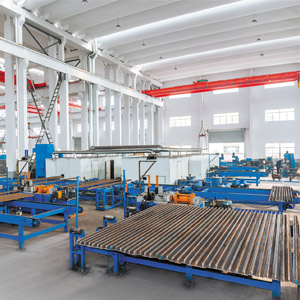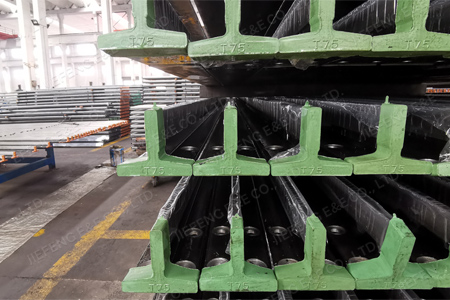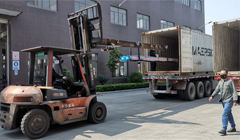- Sitemap
- |
- Download
- |
- Blog
- |
- Contact Us
- |
- Inquiry List
Categories
Contacts Info.
HOT NEWS
Description
Elevator Guide rails
Elevator guide rail is an elevator component consisting of steel rail and connecting plate, which is divided into car rail and pair heavy rail. From the cross-section shape is divided into T-shaped,L-shaped and hollow three forms. At the same time, the guide rail plays a guiding role, bearing the impact of the car, elevator braking, safety pliers when emergency braking impact. The size of these forces is related to the load quality and speed of the elevator, so the rails should be selected according to the elevator speed and load quality. Usually referred to as the car rail as the main rail, the heavy rail as the secondary rail.

Category: Solid rails to heavy hollow rails and escalator rails
Importance: Safety comfort
Installation technical requirements: Each rail has at least two rail supports
Brief introduction
Elevator rail is the elevator up and down in the wellway safety track, the rail is installed on the wellway wall, by the rail frame, rail support fixed to connect to the wellway wall. The rail commonly used in elevators is the "T" type rail. Strong rigidity, high reliability, safe and cheap and so on. The rail plane must be smooth and free of visible bumps. Since the rails are the shuttle rails for boots and safety pliers on the elevator car, they must be installed with a gap. At the same time, the rail in the elevator speeding accident to bear the responsibility of stopping the elevator, so its rigidity can not be ignored.
Elevator rail is installed in the elevator shaft or between the floors of two or more columns of vertical or tilted rigid track, to ensure that the car and the weight along its up and down movement, to ensure that the escalator and automatic sidewalk rung along its tilt or horizontal movement, for the elevator car, heavy device or rung to provide guidance. From the definition of the rail, it can be seen that the rail is an important reference part of vertical elevator, automatic elevator, automatic sidewalk rung, it controls the elevator car, escalator and automatic sidewalk rung running trajectory, to ensure the transmission of operating signal, it is also an important part involving elevator safety and operation quality

Importance analysis
Elevator rails guide the car and the heavy unit while the elevator is running.
It also plays the supporting role of safety clamp braking and is an important part of the elevator system.
The importance of rails is analyzed below in terms of elevator safety and comfort.
1)Security. Elevator rails affect the safety of elevators mainly because of the material of the rails. The rail material is too strong or uneven (local too hard), clamping when the clamps brake will not get enough friction, will cause brake failure, the car crash this elevator accident the most serious operating conditions. The rails should also have sufficient strength to ensure the support of the car and impact force when the safety clamps are braked.
2)Comfort. Elevator rails affect elevator comfort in several ways:
a. The connection accuracy of the rail: The connection precision of the solid rail is guaranteed by the end dimension of the rail and the symmetry of the yin and yang rail, and the connection accuracy of the hollow rail and the ladder guide is guaranteed by the end size and shape tolerance of the rail, and the connection precision of the rail directly affects the smoothness and comfort of elevator operation.
b. Rail guide surface roughness: Rail guide surface roughness directly affects the smooth operation of the guide boots on the guide surface, but also affects the storage of lubricants, thereby affecting the quality of operation of the car.
c. The straightness and distortion of the rail: any point of bending and twisting on the rail will give the car a side force, affecting the straight-line movement of the car up and down, so that the car has a wiggle, with the elevator speed increases, the car will have vibration, thus affecting comfort.

Classify
Elevator rails are divided into three categories: solid rails, heavy hollow rails and escalator rails.
Solid rail is a machined guide rail, is made of rail profiles by mechanical processing guide surface and connection parts, its purpose is in elevator operation for the operation of the car to provide guidance, small specifications of solid rail is also used for heavy guidance. Solid rail specifications are many, according to the weight per meter can be divided into:8K,13K,18K,24K,30K,50K, etc., according to the width of the rail base plate can be divided into T45,T50,T70,T75,T78 ,T82,T89,T90,T114,T127,T140, etc.
With the improvement of elevator comfort requirements and elevator speed, high-precision rail is the development direction of rail production, high-precision rail is on the basis of ordinary rail to improve the accuracy of all aspects, such as guide surface size tolerance, rail height tolerance, groove symmetry tolerance from the original 0.1mm to 0.05mm,and increased a number of end-shaped tolerance requirements and improve the straightness of the guide rail, distortion requirements. High-precision rail is used in high-speed elevator rail, not only the accuracy is higher than ordinary rail, but also in the process to eliminate the potential bending and distortion of the rail factors, such as before the guide surface processing of the rail profile to carry out adequate aging treatment, to reduce residual stress in the rail profile, before the processing end size and before Seismo to carry out a full aging treatment, fully release the internal stress, to reduce the stress caused by the rail bend after the rail installation.
The heavy hollow guide rail is a cold-bending rolling guide rail, which is cold-bended by rolled sheet through a multi-hole mold and is mainly used to provide guidance for the weight in elevator operation. Hollow rails can be divided into TK3,TK5per meter byweight,and can be divided into straight edges and flip edges, i.e. TK5 and TK5A,according to the end face shape of therails.
Escalator rails are cold-bending rolling guides, mainly used for the support and guidance of escalators and escalators. Each escalator enterprise uses a variety of escalator rails of various cross-sectional shapes according to their design needs, i.e. they use their own escalator rail standards.
Installation
GB10060-93-lt; Elevator installation acceptance specifications and technical requirements for the installation of rails:
1. Each rail has at least two rail , between 2-2.5M, and in exceptional cases, measures should be taken to ensure that the rail installation meets the bending strength requirements specified in GB7588-2003. The level of the rail support shall not be greater than 1.5%,and the ground bolt or bracket of the rail support shall not be buried directly at a depth of less than 120mm ded.
2. Boots should not be crossed when the elevator is on top.
3. The deviation per 5M per 5M of the mounting baseline for each column of rail work should not be greater than the following values: : 0.6mm for pairs of heavy rails with safety clamps in the car and 1.0mm for T-pairs of heavy rails without safety clamps.
4. The rail application pressure plate is fixed to the rail frame and should not be welded or directly connected.
5. Distance deviation between the top faces of the two columns of rails: the car is s2-0and the pair of heavyrails is .3-0.
6. When a baseline is installed, each rail should be detected relative to the entire line of the baseline, taking the maximum deviation value

JIEFENG ELEVATOR GUIDE RAIL CO. LTD
No.5 Xiadong Road,
Jiangyin city, Jiangsu province, P.R. China 214400
Tel: +86 (0)510 86100268
Email: sales@elevator-rail.com
Office Hours: 8:30 am to 5:00 pm Beijing Time
Elevator guide rail is an elevator component consisting of steel rail and connecting plate, which is divided into car rail and pair heavy rail. From the cross-section shape is divided into T-shaped,L-shaped and hollow three forms. At the same time, the guide rail plays a guiding role, bearing the impact of the car, elevator braking, safety pliers when emergency braking impact. The size of these forces is related to the load quality and speed of the elevator, so the rails should be selected according to the elevator speed and load quality. Usually referred to as the car rail as the main rail, the heavy rail as the secondary rail.

Category: Solid rails to heavy hollow rails and escalator rails
Importance: Safety comfort
Installation technical requirements: Each rail has at least two rail supports
Brief introduction
Elevator rail is the elevator up and down in the wellway safety track, the rail is installed on the wellway wall, by the rail frame, rail support fixed to connect to the wellway wall. The rail commonly used in elevators is the "T" type rail. Strong rigidity, high reliability, safe and cheap and so on. The rail plane must be smooth and free of visible bumps. Since the rails are the shuttle rails for boots and safety pliers on the elevator car, they must be installed with a gap. At the same time, the rail in the elevator speeding accident to bear the responsibility of stopping the elevator, so its rigidity can not be ignored.
Elevator rail is installed in the elevator shaft or between the floors of two or more columns of vertical or tilted rigid track, to ensure that the car and the weight along its up and down movement, to ensure that the escalator and automatic sidewalk rung along its tilt or horizontal movement, for the elevator car, heavy device or rung to provide guidance. From the definition of the rail, it can be seen that the rail is an important reference part of vertical elevator, automatic elevator, automatic sidewalk rung, it controls the elevator car, escalator and automatic sidewalk rung running trajectory, to ensure the transmission of operating signal, it is also an important part involving elevator safety and operation quality

Importance analysis
Elevator rails guide the car and the heavy unit while the elevator is running.
It also plays the supporting role of safety clamp braking and is an important part of the elevator system.
The importance of rails is analyzed below in terms of elevator safety and comfort.
1)Security. Elevator rails affect the safety of elevators mainly because of the material of the rails. The rail material is too strong or uneven (local too hard), clamping when the clamps brake will not get enough friction, will cause brake failure, the car crash this elevator accident the most serious operating conditions. The rails should also have sufficient strength to ensure the support of the car and impact force when the safety clamps are braked.
2)Comfort. Elevator rails affect elevator comfort in several ways:
a. The connection accuracy of the rail: The connection precision of the solid rail is guaranteed by the end dimension of the rail and the symmetry of the yin and yang rail, and the connection accuracy of the hollow rail and the ladder guide is guaranteed by the end size and shape tolerance of the rail, and the connection precision of the rail directly affects the smoothness and comfort of elevator operation.
b. Rail guide surface roughness: Rail guide surface roughness directly affects the smooth operation of the guide boots on the guide surface, but also affects the storage of lubricants, thereby affecting the quality of operation of the car.
c. The straightness and distortion of the rail: any point of bending and twisting on the rail will give the car a side force, affecting the straight-line movement of the car up and down, so that the car has a wiggle, with the elevator speed increases, the car will have vibration, thus affecting comfort.

Classify
Elevator rails are divided into three categories: solid rails, heavy hollow rails and escalator rails.
Solid rail is a machined guide rail, is made of rail profiles by mechanical processing guide surface and connection parts, its purpose is in elevator operation for the operation of the car to provide guidance, small specifications of solid rail is also used for heavy guidance. Solid rail specifications are many, according to the weight per meter can be divided into:8K,13K,18K,24K,30K,50K, etc., according to the width of the rail base plate can be divided into T45,T50,T70,T75,T78 ,T82,T89,T90,T114,T127,T140, etc.
With the improvement of elevator comfort requirements and elevator speed, high-precision rail is the development direction of rail production, high-precision rail is on the basis of ordinary rail to improve the accuracy of all aspects, such as guide surface size tolerance, rail height tolerance, groove symmetry tolerance from the original 0.1mm to 0.05mm,and increased a number of end-shaped tolerance requirements and improve the straightness of the guide rail, distortion requirements. High-precision rail is used in high-speed elevator rail, not only the accuracy is higher than ordinary rail, but also in the process to eliminate the potential bending and distortion of the rail factors, such as before the guide surface processing of the rail profile to carry out adequate aging treatment, to reduce residual stress in the rail profile, before the processing end size and before Seismo to carry out a full aging treatment, fully release the internal stress, to reduce the stress caused by the rail bend after the rail installation.
The heavy hollow guide rail is a cold-bending rolling guide rail, which is cold-bended by rolled sheet through a multi-hole mold and is mainly used to provide guidance for the weight in elevator operation. Hollow rails can be divided into TK3,TK5per meter byweight,and can be divided into straight edges and flip edges, i.e. TK5 and TK5A,according to the end face shape of therails.
Escalator rails are cold-bending rolling guides, mainly used for the support and guidance of escalators and escalators. Each escalator enterprise uses a variety of escalator rails of various cross-sectional shapes according to their design needs, i.e. they use their own escalator rail standards.
Installation
GB10060-93-lt; Elevator installation acceptance specifications and technical requirements for the installation of rails:
1. Each rail has at least two rail , between 2-2.5M, and in exceptional cases, measures should be taken to ensure that the rail installation meets the bending strength requirements specified in GB7588-2003. The level of the rail support shall not be greater than 1.5%,and the ground bolt or bracket of the rail support shall not be buried directly at a depth of less than 120mm ded.
2. Boots should not be crossed when the elevator is on top.
3. The deviation per 5M per 5M of the mounting baseline for each column of rail work should not be greater than the following values: : 0.6mm for pairs of heavy rails with safety clamps in the car and 1.0mm for T-pairs of heavy rails without safety clamps.
4. The rail application pressure plate is fixed to the rail frame and should not be welded or directly connected.
5. Distance deviation between the top faces of the two columns of rails: the car is s2-0and the pair of heavyrails is .3-0.
6. When a baseline is installed, each rail should be detected relative to the entire line of the baseline, taking the maximum deviation value

JIEFENG ELEVATOR GUIDE RAIL CO. LTD
No.5 Xiadong Road,
Jiangyin city, Jiangsu province, P.R. China 214400
Tel: +86 (0)510 86100268
Email: sales@elevator-rail.com
Office Hours: 8:30 am to 5:00 pm Beijing Time







